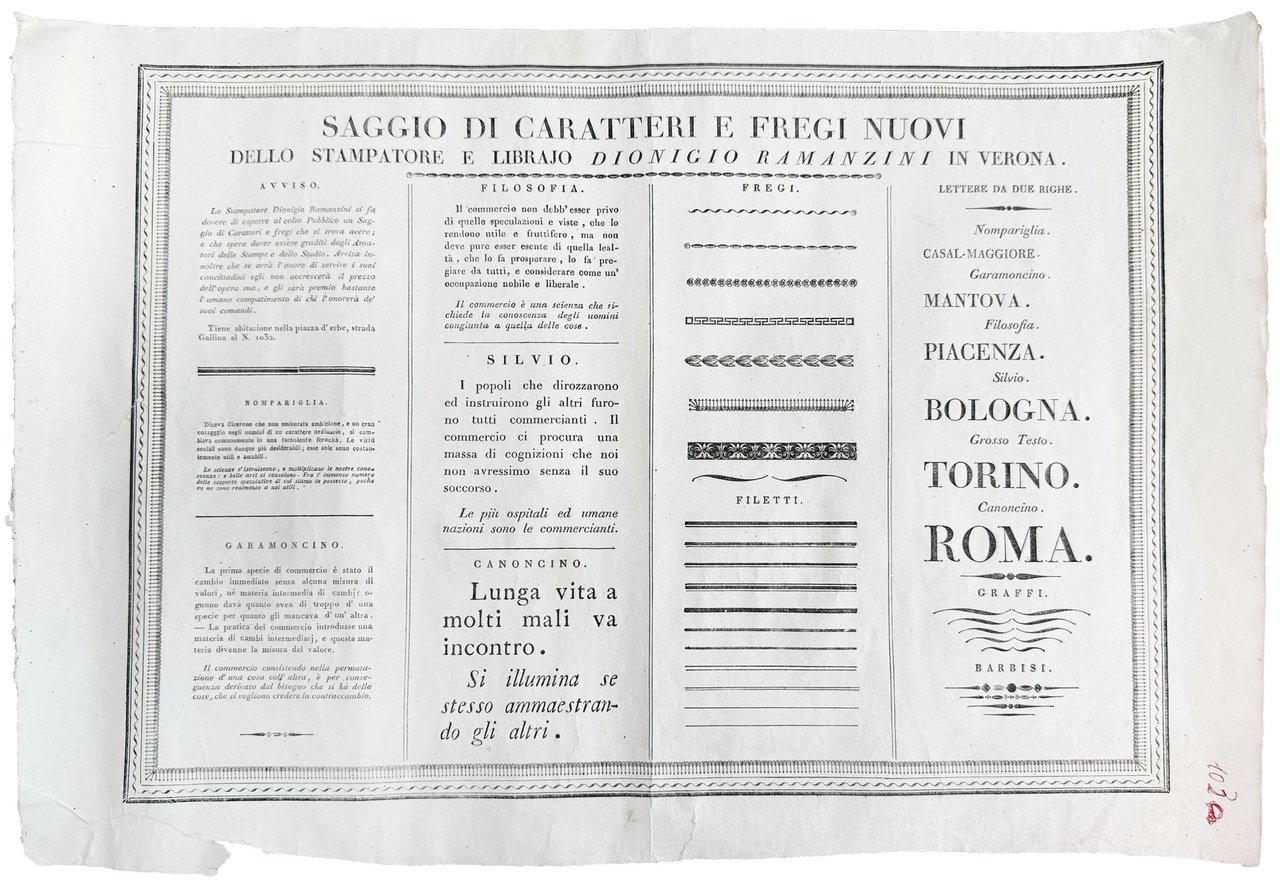
Libri antichi e moderni
STAMPERIA DIONISIO RAMANZINI-VERONA
Saggio di caratteri e fregi nuovi dello Stampatore e librajo Dionigio Ramanzini in Verona
1830 ca.
900,00 €
Govi Libreria Antiquaria
(Modena, Italia)
Le corrette spese di spedizione vengono calcolate una volta inserito l’indirizzo di spedizione durante la creazione dell’ordine. A discrezione del Venditore sono disponibili una o più modalità di consegna: Standard, Express, Economy, Ritiro in negozio.
Condizioni di spedizione della Libreria:
Per prodotti con prezzo superiore a 300€ è possibile richiedere un piano rateale a Maremagnum. È possibile effettuare il pagamento con Carta del Docente, 18App, Pubblica Amministrazione.
I tempi di evasione sono stimati in base ai tempi di spedizione della libreria e di consegna da parte del vettore. In caso di fermo doganale, si potrebbero verificare dei ritardi nella consegna. Gli eventuali oneri doganali sono a carico del destinatario.
Clicca per maggiori informazioniMetodi di Pagamento
- PayPal
- Carta di Credito
- Bonifico Bancario
-
-
Scopri come utilizzare
il tuo bonus Carta del Docente -
Scopri come utilizzare
il tuo bonus 18App
Dettagli
Descrizione
This is apparently an unrecorded type specimen of the Verona publishing house Dionisio Ramanzini, which was founded around 1729 and remained active almost seamlessly until the 1830s.
The broadsheet, which offers samples of different printing types and ornaments, opens with a note in which the typographer states that he is honoured to offer his services to bibliophiles and scholars, and that he will not increase his prices.
Dionisio Ramanzini was one of the leading Veronese printers of the eighteenth century. His shop, located in Contrada San Tomio, remained in business throughout the century until the suppression of the “Corporazione dei Tipografi, Librai e Cartai” in 1804. Ramanzini began his career as a bookseller around 1728, although he was not recorded in the guild's register until October 1739. His early years were closely linked to Angelo Targa, and both typographers used Giolito de' Ferrari's famous device of the phoenix, albeit with different initials. In 1742, the workshop's presses were damaged by a disastrous fire. Ramanzini was able to recover thanks to the financial support of some local nuns. The founder, Dionisio (or Dionigi), died in 1785, passing the business on to his son, Giuseppe Ignazio, who was born in 1752 and, in continuing his father's work, decided to keep the firm's name as Dionigi Ramanzini. He also gave the name Dionigi to his son, who was born in 1782 and joined the business just as it was forced to close, along with the entire Corporation of Typographers, Booksellers and Papermakers suppressed in 1804. From 1739 (when the company registered with the guild) to 1790, one hundred and twenty printing licences were issued, on average equating to around three titles per year. The Ramanzini printing house was most notable for its numerous antiquarian and religious works of popular interest, as well as theatrical booklets and a few scientific treatises related to the Italian Society of Sciences (cf. E. Bao, In bianco e nero. Il libro illustrato veronese nel XVIII secolo, Dissertation thesis, University of Verona, 2018, I, pp. 172-176; and F. M. Errico, Cartai, librai e stampatori nella Verona del Settecento, Dissertation thesis, University of Verona, 1994-1995, pp. 176 and 181).
The present type specimen appears to date from the final years of the printing house's second period of activity, following its reopening after the suppression of the guild in 1804 and its move from Contrà San Tomio to Strada Gallina, 1032 (always near Piazza delle Erbe).

